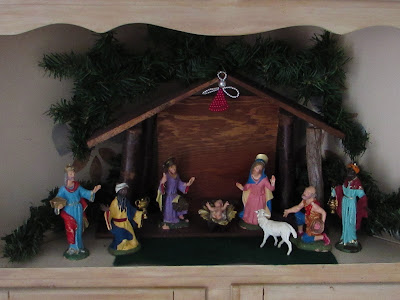Fifty two Christmases ago, as newly-weds, Donna and I set up a nativity in a corner hutch. The hutch has been a present from my father. My parents had given us a set of nativity characters without the shelter that usually houses a Christmas display. So, I "built" a manger setting for the figures to go in. I used scrap materials -- pine board for the bottom, a piece of plywood for the back, cedar shingles for the roof, and four birch roof supports I cut from a tree near the little cabin we were living in. I tacked it all together with nails I had salvaged from other jobs. In those days, I salvaged a lot of things.
Over the years we repaired that nativity even as we began collecting nativity sets from other countries. My mother started us on the path toward an international collection by giving us an olive-wood nativity purchased on a trip she took to Israel with her sisters in the early years after all of their husbands had died.
Our collection began to grow first through gifts -- such as my mother's -- from family and friends who traveled or who had come from other lands, and then through intentional purchases when we have been able to travel ourselves.
From the beginning, we didn't want a lot of nativities that all had a similar "look." The idea that informed our collecting has been that the nativities should have both a personal connection and a cultural connection.
When our youngest son and his future wife, Rachael, went to Africa with Jon and Barb Arensen as part of the Houghton Tanzania program, they brought home a nativity carved in black stone.
This black stone carving (above) was the first of, now, a number of African nativities that offer different ways of seeing and understanding the Advent story. One, from a former Houghton College (University) professor, is made of corn husks. Another is made of stiff wire and cloth in "local" patterns.
A good number of our nativities are tiny. From Donna's mom we inherited a nativity carved and/or chiseled from a single piece of stone. It fits in the palm of one hand. At one point, after a bit of rough handling, Joseph's head broke off, but I was able to glue it back on with a bit of epoxy.
A few years ago one of our Korean home-stay daughters sent us a tiny Navajo nativity she bought in Arizona during a trip she took with her parents following her graduation from college. We were also given an extremely tiny Inuit nativity, complete with a miniscule penguin, which is an interesting feature of this display.
This past May, during our amazing trip to Egypt, we found Egyptian nativities both in Cairo and in Luxor. This nativity, made of clay, tells many stories for us, as one might imagine. There is at heart the Advent story, the Incarnation story with its central figures -- Mary, Joseph, and so forth, with Jesus in his manger-bed -- that gives Christmas its significance and gravity. There are also the materials and artistry that root these figures to Egypt, characteristics that tell us the Christmas story is a shared, global story, the story of the family of God. And a third story is personal -- how this universal and universally shared story connects us personally with believers in Egypt.
My favorite among our nativities, however, is one I brought home from Russia in 2004. It not only tells the stories already mentioned, but it carries for me added significance. I bought it from the man who carved and painted it, our guide, translator, mentor, brother in Christ, and my good friend Andrew S. It is Russian to the core; carved with care and love and attention to detail, it tells us of the hope we share in Jesus. In these days of raging conflict and misunderstanding, it is a vivid reminder of the message of the gospel: The coming of the Christ child proclaims Peace on earth and good will to all mankind.











I thoroughly enjoyed reading about all of the nativity scenes. Thank you very much for sharing.
ReplyDelete